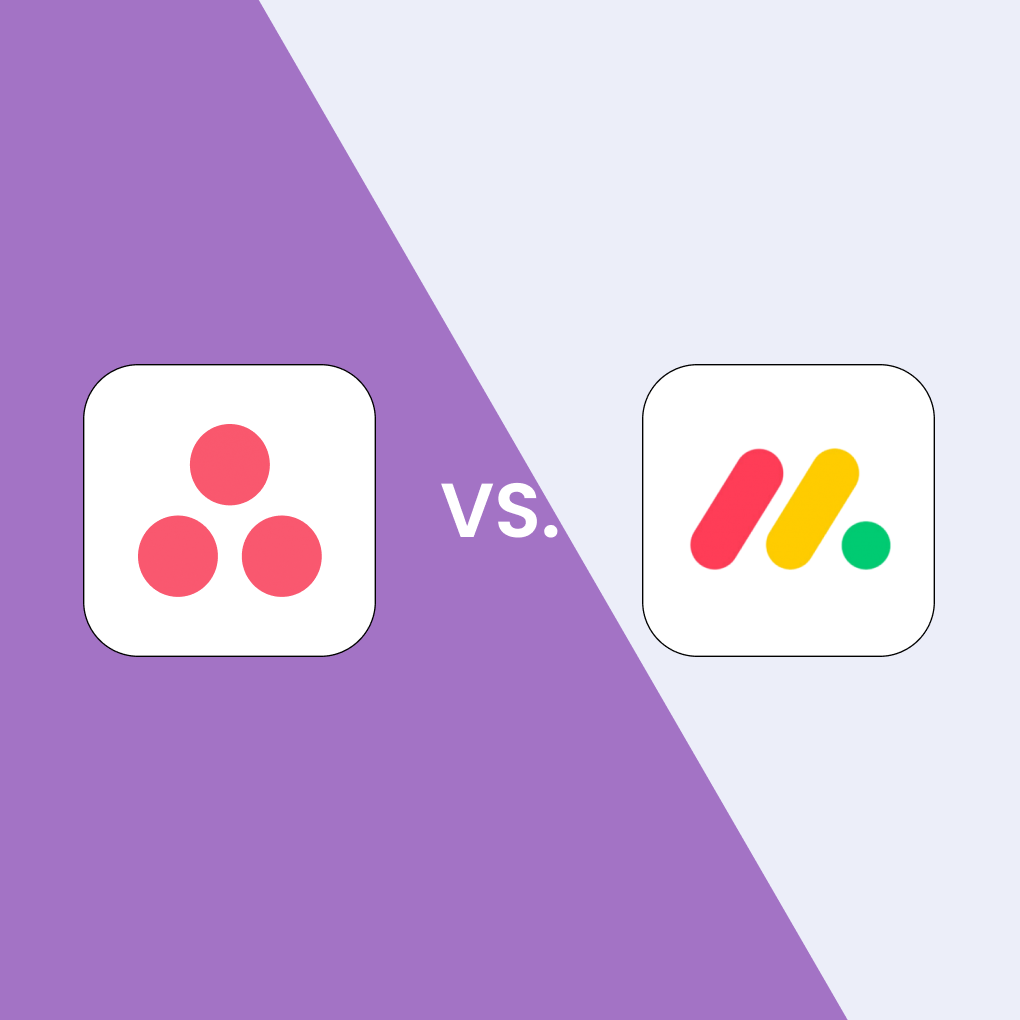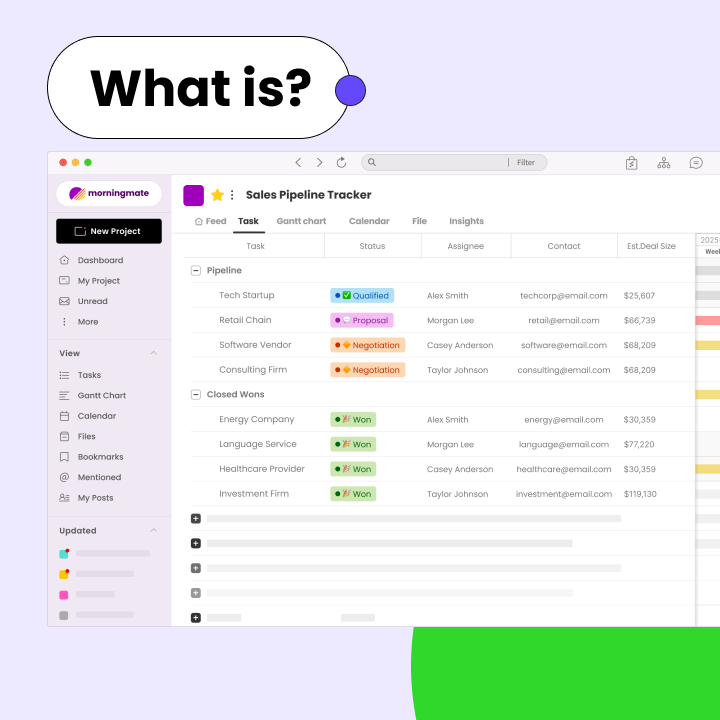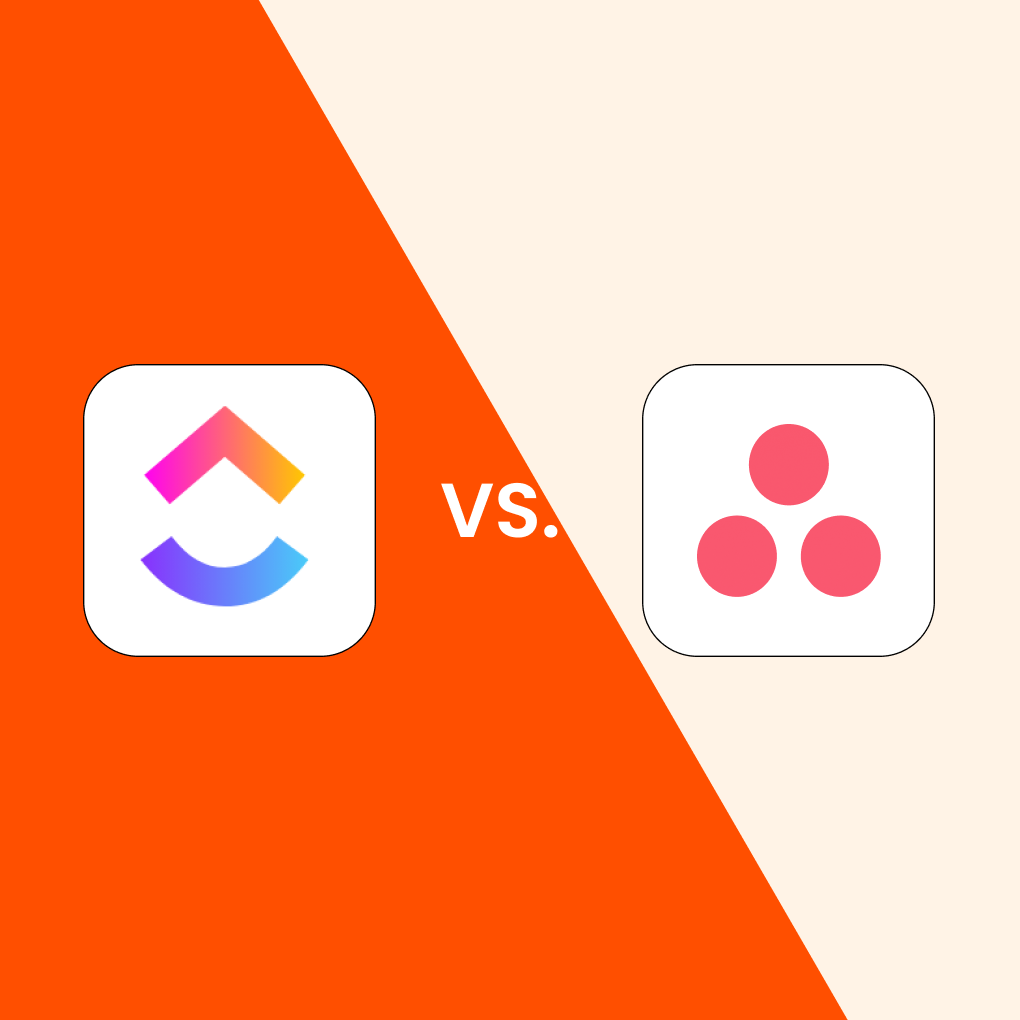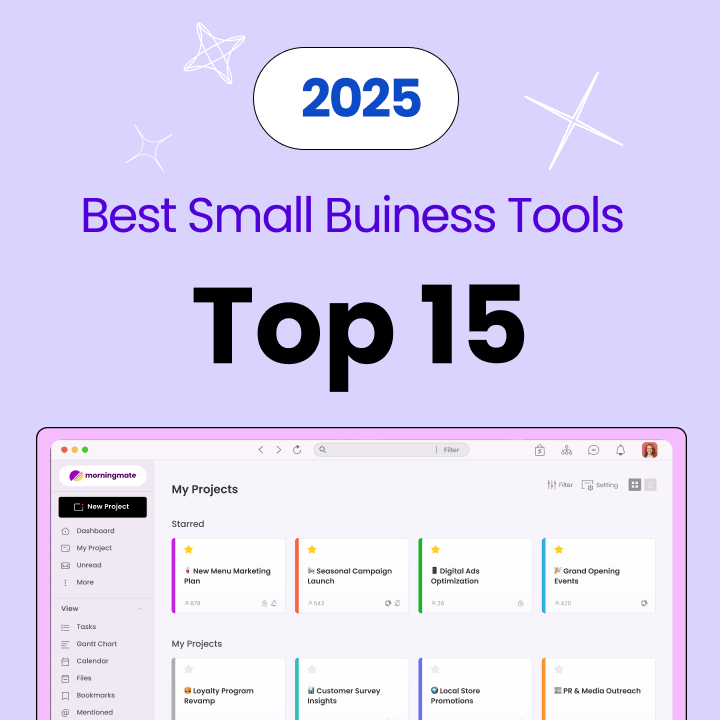Selecting the right project management tool can significantly impact your team’s productivity. With countless options available, two platforms consistently stand out: Asana and Monday.com. While both offer powerful features, they cater to different needs and work styles. This detailed comparison will guide you in choosing the platform that best fits your team’s goals, budget, and workflow preferences.
Asana vs. Monday.com: A Quick Overview
What Do These Tools Offer?
Asana is a work management platform designed to help teams organize, track, and manage their tasks. Initially focused on task management, it has evolved into a comprehensive solution for project planning, team collaboration, and goal tracking. Its clean and minimalist interface appeals to teams that value simplicity without compromising functionality.
In contrast, Monday.com presents itself as a “Work OS” that adapts to any team or industry. With its colorful, visual boards, it emphasizes customization and flexibility. This platform allows teams to create workflows that reflect their existing processes rather than forcing them into predefined structures.
Why This Comparison Matters in 2025
The project management software landscape has matured, with both platforms introducing AI-powered features, advanced automation, and enhanced collaboration tools. Both Asana and Monday.com place their automation features behind a paywall, offering similar limits at each tier (starting with 250 monthly automations, increasing to 25,000 or more with upgrades). Understanding these evolving capabilities is essential for making an informed decision that will benefit your team in the long run.
The rise of remote and hybrid work models has also transformed team collaboration. Both platforms have adapted by enhancing communication features, mobile apps, and integration options. However, their approaches to addressing these challenges differ significantly, making the choice between them more nuanced than ever.
Core Project Management Features Compared
Task & Workflow Management
Asana excels in traditional task management with its intuitive system for creating, assigning, and tracking tasks. Users can break tasks into subtasks, assign them to multiple team members, and organize them within projects. The platform’s strength lies in its simplicity—creating and managing tasks feels natural and requires minimal training.
Monday.com takes a board-based approach to task management. Each item on a board represents a task, project, or piece of work. What sets Monday.com apart is its flexibility in defining what each item represents. Teams can create custom columns to track various types of information, from simple status updates to complex data fields.
The key difference is structure versus flexibility. Asana offers a more structured approach, ideal for teams following established project management methodologies. In contrast, Monday.com provides unlimited customization but requires more setup time to achieve optimal workflows.
Views & Customization (Kanban, Timeline, Calendar)
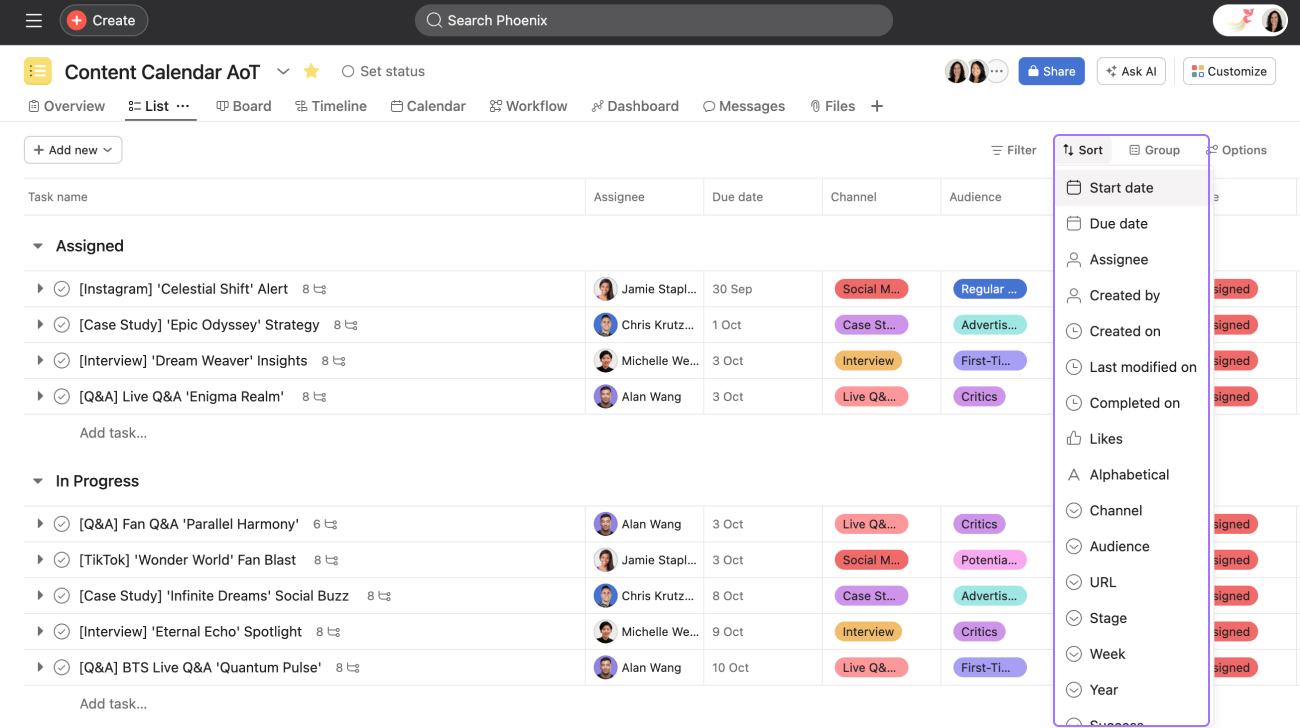
Both platforms offer multiple project views, each with its strengths. Asana provides List, Board (Kanban), Timeline (Gantt), and Calendar views. Its Timeline view is particularly robust, featuring advanced dependency management and resource allocation. The Calendar view integrates seamlessly with external calendars, making it easy to align project deadlines with personal schedules.
Monday.com also offers similar view options but with a more visually appealing design. Its Kanban boards are highly customizable, featuring color-coding, custom fields, and visual indicators. While its Timeline view is functional, it lacks some of the advanced features found in Asana. Monday.com shines with unique views like Map view for location-based projects and Chart view for data visualization.
Customization capabilities favor Monday.com significantly. Teams can create custom dashboards, design their own workflow templates, and modify nearly every aspect of their boards. Asana offers customization through custom fields and templates but within a more structured framework.
Automations and AI Features

Asana’s higher tiers include advanced features like approval workflows and complex date-based automations. Its automation engine focuses on practical, workflow-oriented tasks such as moving projects through stages, assigning work based on criteria, and sending notifications. AI features include smart suggestions for task assignments and project insights.
Monday.com’s automation builder is more visual and user-friendly, employing a recipe-based approach that requires no technical expertise. Users can create complex multi-step automations using simple if-then logic. The platform’s AI capabilities extend to predictive analytics and workload forecasting.
Both platforms limit automation usage on lower-tier plans, but Monday.com generally offers more generous automation quotas across its pricing tiers. For teams that rely heavily on automation, this could be a crucial factor.
Goal Tracking and Reporting Dashboards
Asana’s Goals feature enables teams to set and track objectives at various levels, from individual tasks to company-wide initiatives. Its reporting dashboard provides insights into project progress, team workload, and goal completion rates. Portfolio management features allow executives to view multiple projects simultaneously.
Monday.com’s dashboard functionality is more flexible but requires additional setup. Teams can create custom widgets to track any metric, from budget utilization to team satisfaction scores. The platform excels in visual reporting, using charts, graphs, and progress indicators that make data easy to understand.
For teams needing sophisticated reporting, Monday.com’s flexibility offers an advantage. However, Asana’s goal-tracking features are more integrated into the overall workflow, making them easier to adopt and maintain.
Team Collaboration & Communication
Commenting, Notifications, and Mentions
Both Asana and Monday.com excel in basic communication through their commenting systems, @mentions, and notification management. Asana features a threaded commenting system that keeps conversations organized and easy to follow. Users can create tasks directly from comments, seamlessly connecting discussion to action.
In contrast, Monday.com offers a more visual communication experience. Its activity feeds display updates across all boards, and the platform includes emoji reactions, creating a more engaging, social media-like interface. Automatic updates occur when board items change, minimizing the need for manual status updates.
Effective notification management is essential for productivity, and both platforms allow users to customize notification triggers. Asana typically adopts a more conservative approach with its default settings, while Monday.com takes a proactive stance, keeping users informed of changes.
File Sharing and Document Collaboration
The file management capabilities of Asana and Monday.com differ significantly. Asana allows straightforward file attachments with preview options for common file types. Files are organized within tasks and projects, making them easy to find. While it integrates with cloud storage services, it does not offer native document editing.
Monday.com also supports file attachments but features a more visual file management system. Its file gallery view simplifies browsing and managing large numbers of files. Like Asana, it lacks native document editing but compensates with strong integration options.
Neither platform matches the document collaboration capabilities of dedicated tools like Google Workspace or Microsoft 365, but both integrate well with these services to create seamless workflows.
Cross-Department Communication Features
Asana facilitates cross-department communication through its project and team structure. Teams can create projects that involve multiple departments, and its proofing feature allows for structured feedback on creative work. The Messages feature provides channels for team-wide communication.
Monday.com enhances cross-department collaboration with its board-sharing capabilities. Teams can share specific boards or views with other departments while maintaining control over sensitive information. Its notification system keeps all stakeholders informed without overwhelming them with irrelevant updates.
Pricing & Plans
Asana Pricing Overview
Asana offers four pricing tiers: a free Personal plan, a $13.49 per user per month Starter plan, a $30.49 per user per month Advanced plan, and two scalable Enterprise plans. The free plan is generous, accommodating up to 15 team members with basic project management features. In comparison, Monday.com’s free plan allows only 2 users, making Asana a better choice for small teams on a budget.
The Starter plan introduces Timeline view, custom fields, advanced search, and reporting dashboards. The Advanced plan adds portfolios, workload management, advanced integrations, and more automation rules. Enterprise plans include enhanced security, administrative controls, and priority support.
Asana does not charge extra for API calls, integrations, or file storage, and there are no limits on the number of boards per dashboard. This transparent pricing model helps teams budget effectively without worrying about unexpected costs.
Monday.com Pricing Overview
Monday.com features a tiered pricing structure with various options, though it may become more expensive for larger teams. The platform offers a free plan along with four paid plans. The Basic Projects plan stands out as a great value, offering a solid range of features at a lower price.
The Basic plan starts at $9 per user per month and includes unlimited boards, 5GB of storage, and basic integrations. The Standard plan, priced at $12 per user per month, adds timeline and calendar views, as well as guest access. The Pro plan, at $19 per user per month, includes advanced features like time tracking, chart view, and automation. The Enterprise plan offers enhanced security and administrative features.
While Monday.com’s pricing can escalate quickly, especially for teams needing advanced features, it often provides more functionality at lower tiers compared to Asana.
Which Offers Better Value for Your Team?
For teams with more than five members or those needing features not available in free plans, Monday.com generally offers better pricing across all categories. For smaller teams, Asana’s generous free plan delivers excellent value. Larger teams requiring advanced features may find that Monday.com provides more functionality for each dollar spent.
The value also depends on how features are utilized. Teams that heavily rely on automation, custom fields, and advanced reporting may find Monday.com’s feature-rich tiers more cost-effective. Conversely, teams needing basic project management with occasional advanced features might prefer Asana’s predictable pricing structure.
Be mindful of hidden costs as well. Both platforms charge for add-ons and advanced features, but Monday.com’s per-seat pricing for integrations and apps can accumulate quickly. Asana’s flat-rate approach to most features offers more predictable costs.
Integrations and Extensibility
Native Integrations
Both Asana and Monday.com provide extensive integration options, but they take different approaches. Asana emphasizes deep, native integrations with popular productivity tools, including Slack, Microsoft Teams, Adobe Creative Cloud, Salesforce, and major email platforms. These integrations feel seamless and help maintain workflow continuity.
In contrast, Monday.com adopts a marketplace-oriented strategy, offering hundreds of integrations with a wide range of business tools, from CRM systems to accounting software. While this variety is impressive, the quality of integrations can vary, and some third-party connections may require extra setup or fees.
API and Developer Tools
Asana features a robust REST API with thorough documentation, making it appealing to development teams looking to create custom integrations. The platform also supports webhooks for real-time data synchronization and GraphQL endpoints for efficient data queries.
Monday.com’s API is equally powerful but emphasizes no-code and low-code solutions, making it accessible to users without technical backgrounds. Its extensive API documentation and SDK libraries for popular programming languages further enhance usability.
Marketplace Apps & Workflows
Monday.com boasts a larger marketplace, offering apps tailored to specific industries and use cases. Its app ecosystem includes tools for HR management and complex manufacturing workflows. However, many advanced apps come with additional subscription fees.
Asana’s app ecosystem is more curated, focusing on high-quality integrations with essential business tools rather than niche applications. This results in fewer options but ensures more reliable connections.
Ease of Use & User Experience
UI/UX Design Comparison
Asana’s interface emphasizes simplicity and clarity. Its clean, minimal design reduces cognitive load, allowing users to concentrate on their tasks. Navigation is intuitive, with consistent design patterns throughout the platform, making it ideal for those who prioritize functionality over aesthetics.
Monday.com, on the other hand, adopts a vibrant, visual approach. Its engaging and modern interface offers numerous visual cues and customization options. However, this richness can be overwhelming for new users, requiring more time to master. Once familiar, users can enjoy a highly personalized experience.
User preferences often align with their personalities. Teams that value efficiency and minimal distractions typically prefer Asana, while those seeking engaging, customizable interfaces are drawn to Monday.com.
Onboarding Experience
Asana’s onboarding process is streamlined, enabling users to become productive quickly. The platform offers guided tours, template libraries, and progressive feature disclosure, allowing new users to manage projects within minutes without extensive training.
In contrast, Monday.com’s onboarding is more comprehensive but time-consuming. It provides extensive tutorials, video training, and hands-on setup assistance. While the learning curve is steeper, users gain a deeper understanding of the platform and can create more customized setups.
Both platforms offer excellent support resources, but Monday.com’s training materials are more extensive and tailored to specific industries.
Mobile App Capabilities
Mobile functionality is essential for modern project management. Asana’s mobile apps excel in offline capabilities and maintain feature parity with the desktop version, allowing users to create tasks, update project statuses, and collaborate effectively from their devices.
Monday.com’s mobile experience is visually appealing and retains the platform’s colorful interface. While the apps offer good functionality, they may have limitations compared to the desktop version, particularly with complex board configurations that may not display well on mobile screens.
Both platforms regularly update their mobile apps, but Asana tends to prioritize feature parity, while Monday.com focuses on optimizing the mobile experience.
Security, Privacy, and Compliance
Data Protection Measures
Both Asana and Monday.com prioritize security with robust protections. Asana employs AES-256 encryption for data at rest and TLS 1.2+ for data in transit. The platform undergoes regular security audits and maintains comprehensive security documentation.
Similarly, Monday.com utilizes strong encryption standards and security practices. It offers advanced features such as single sign-on (SSO), two-factor authentication, and IP restrictions. Both platforms keep detailed audit logs to ensure compliance.
Certifications (SOC 2, GDPR, HIPAA)
Asana holds SOC 2 Type II certification and adheres to GDPR regulations. It also provides HIPAA-compliant configurations for healthcare organizations, though this requires specific setup and an Enterprise-level subscription.
Monday.com has comparable certifications, including SOC 2 Type II, ISO 27001, and GDPR compliance. The platform also offers compliance features tailored for industries like finance and healthcare.
Both platforms regularly update their compliance status, so organizations with strict regulatory needs should confirm current certifications before making decisions.
User Permission Controls
Asana offers detailed permission controls at the project, team, and organizational levels. Administrators can manage who can view, edit, or oversee various aspects of the workspace. Guest access allows external collaborators to engage in specific projects without full platform access.
Monday.com features a similarly sophisticated permission system, with role-based access controls and board-level permissions. It allows for nuanced sharing options, including view-only access to specific columns or rows within boards.
Customer Support and Community
Support Channels: Chat, Email, Knowledge Base
Asana provides various support channels, including email support, live chat for paid plans, and a comprehensive knowledge base. Its community forum is active, offering peer-to-peer assistance. Premium plans include priority support for quicker response times.
Monday.com offers similar support options, with the added benefit of phone support for higher-tier plans. The support team is known for its responsiveness and helpfulness, and the knowledge base is extensive and frequently updated.
User Communities and Learning Resources
Both platforms boast active user communities and extensive learning resources. Asana’s community emphasizes best practices and workflow optimization, offering certification programs and regular webinars on project management topics.
Monday.com has a larger and more diverse community, featuring industry-specific groups and regional chapters. It provides extensive video training, template libraries, and case studies. Monday.com Academy offers structured learning paths tailored to different roles and industries.
Real-World Customer Reviews
Customer satisfaction ratings are generally high for both platforms, each with its strengths. Asana users often commend its simplicity and reliability, though some express concerns about limited customization options and the need for third-party integrations for advanced features.
Monday.com is praised for its flexibility and visual appeal. Users appreciate its customization capabilities and responsive support team, but some criticize its complexity for simple tasks and pricing concerns for larger teams.
Morningmate: Simple Alternative to Both for Project and Team Management
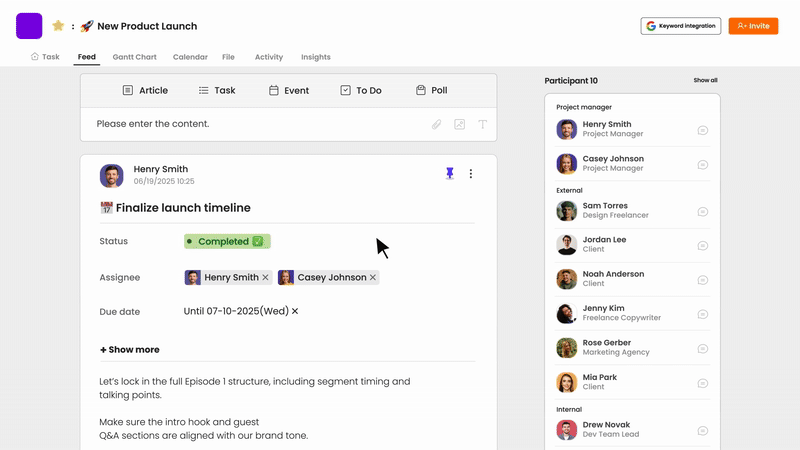
Morningmate provides a powerful, unified alternative to Asana and Monday.com—designed for teams that want streamlined collaboration without the noise. Rather than accumulating dozens of features for marketing purposes, Morningmate focuses on core functionality: project tracking, team messaging, file sharing, and content collaboration in a single, intuitive platform.
Work is organized through a feed-based project system, where posts, task updates, files, and messages are presented chronologically. Teams can create dedicated project rooms to manage timelines, assign tasks, and communicate with internal or external stakeholders. Real-time collaboration is supported through integrated messaging, mentions, and integrations with tools like Google Calendar and Zoom.
Flexible Pricing for Teams (Including Guests)
Morningmate offers a Starter plan at $8.99 per user/month, and a Pro Unlimited plan at $199/month, supporting 30 to 300 users under a fixed pricing model. This allows large teams to scale without incurring high per-seat costs. Additionally, guest access is always free, enabling external collaborators—such as clients or vendors—to join projects without the need for a full license.
This approach makes Morningmate cost-effective for growing teams working across departments or organizations, especially those requiring frequent external participation.
Why Consider Morningmate Over Asana or Monday.com?
Morningmate’s main strength lies in its integrated experience. Rather than separating project management from communication or document sharing, everything is handled within a single workspace—reducing context switching and increasing team efficiency.
For teams frustrated with the complexity of tools like Asana or overwhelmed by the configurability of Monday.com, Morningmate offers a simpler, human-centered design that balances customization with usability. Its flat-rate pricing and inclusive guest access model also mean substantial cost savings for teams working with multiple stakeholders.
Which Tool Is Right for You?
Best for Large Enterprises
Large enterprises often need robust security, compliance features, and extensive integration options. Asana and Monday.com both provide enterprise-level solutions, each with unique strengths.
Asana Enterprise is ideal for organizations with established project management processes. Its structured approach scales effectively across large teams, ensuring a consistent experience. Features like portfolios, workload management, and goal tracking enable executives to maintain visibility in complex organizations.
Monday.com Enterprise is perfect for organizations that require high levels of customization and flexibility. Its adaptability to existing processes makes it suitable for companies with diverse departments and workflows. Advanced automation and reporting features cater to complex business needs.
Morningmate is rapidly growing and currently meets enterprise needs through its Business+ plan, but it may not yet offer the advanced features found in more established platforms.
Best for Small Teams and Startups
Small teams and startups thrive on platforms that are easy to use, budget-friendly, and scalable. Asana’s generous free plan is appealing for very small teams, while its structured approach helps establish effective project management practices from the start.
Monday.com’s visual design and flexibility attract creative teams and startups with unique workflows. Its customization options allow growing teams to adapt their tools without overhauling existing processes.
Morningmate is an excellent choice for small teams seeking integrated communication and project management without the complexity of larger platforms. Its pricing structure and guest access features make it particularly appealing for small agencies and consulting firms.
Best for Non-Technical or Cross-Functional Teams
Teams with limited technical skills or diverse expertise need platforms that are user-friendly and require minimal training. Asana’s clean interface and structured approach make it accessible to all users, regardless of their technical background.
Monday.com’s visual design and no-code automation builder are attractive to non-technical users, though its extensive customization options may overwhelm some teams.
Morningmate focuses on simplicity and integrated functionality, making it ideal for teams that want powerful capabilities without unnecessary complexity. Its emphasis on essential features over excessive options appeals to teams prioritizing productivity.
Final Verdict: Choosing Your Ideal Project Management Tool
Selecting between Asana, Monday.com, and alternatives like Morningmate depends on your team’s specific needs, technical expertise, and growth plans. Each platform excels in different areas and caters to various types of organizations.
Choose Asana if you prioritize simplicity, structured project management, and a generous free tier. It works best for teams following established methodologies and those who prefer functionality over extensive customization. Asana’s transparent pricing and reliable performance make it a solid choice for growing organizations.
Opt for Monday.com if you need extensive customization, visual project management, and industry-specific features. This platform is well-suited for creative teams, agencies, and organizations with unique workflows that don’t fit traditional project management models. Be prepared for a steeper learning curve and potentially higher costs.
Consider Morningmate if you want integrated communication and project management without complexity. This platform is ideal for teams frustrated with feature overload and those seeking cost-effective solutions with guest access. Although newer than established players, Morningmate’s focus on user experience and essential functionality makes it a strong contender.
The project management software landscape is rapidly evolving, with AI integration, improved mobile experiences, and enhanced collaboration features becoming standard. Whichever platform you choose, ensure it aligns with your team’s working style, budget, and long-term growth plans.
Remember, the best project management tool is the one your team will consistently use. Consider trialing multiple platforms, involving key stakeholders in the decision-making process, and evaluating how each option integrates with your existing workflows and tools.
Investing in the right project management platform can lead to improved productivity, better collaboration, and fewer project failures. Take the time to evaluate your options thoroughly, and don’t hesitate to switch if your chosen platform no longer meets your evolving needs.
Ready to transform your project management? Start with free trials of Asana, Monday.com, and Morningmate to experience their differences firsthand. Your team’s productivity depends on choosing the right tool—make an informed decision by testing each platform with your actual projects and workflows.

